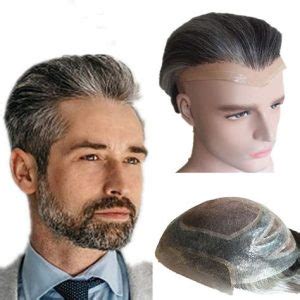What are Toupee System Pins?
Toupee system pins are small, discreet devices used to attach a toupee to the scalp. They typically consist of a pinhead, shaft, and retention mechanism. Pinheads can be made from various materials such as stainless steel, titanium, or gold, while the shaft is usually made from a flexible material to allow for bending and adjustment.

Types of Toupee System Pins
The numerous variations of toupee system pins can be categorized based on several factors:
1. Pinhead Shape
- Round: Provides a wider surface area for better grip
- Oval: A compromise between grip and comfort
- Teardrop: Designed for areas with more hair density
2. Pinhead Material
- Stainless Steel: Durable and affordable, suitable for most applications
- Titanium: Strong and lightweight, hypoallergenic
- Gold: Luxurious option, less common
3. Shaft Flexibility
- Rigid: Provides maximum hold, requires precise placement
- Semi-Flexible: Allows for some adjustment, offers more comfort
- Flexible: Highly adjustable, ideal for curved surfaces
4. Retention Mechanism
- Push-In: Requires a pre-drilled hole in the scalp, provides the strongest hold
- Screw-In: Similar to push-in pins, offers a secure connection
- Grip System: Utilizes a rubber or silicone grip to hold the toupee, suitable for sensitive scalps
- Magnetic: Uses magnets to attach the toupee, no scalp penetration required
Choosing the Right Toupee System Pins
Selecting the appropriate toupee system pins involves careful consideration of the following factors:
- Hair Density: Pinheads with larger surface areas are better suited for areas with dense hair.
- Scalp Sensitivity: Avoid pins with sharp tips or rough edges if the scalp is sensitive.
- Pin Positioning: Choose pinheads that match the shape and curvature of the scalp.
- Flexibility: Rigid pins provide maximum hold, but flexible pins are more comfortable for prolonged wear.
- Retention Mechanism: Push-in pins offer the strongest hold, while grip systems are suitable for sensitive scalps.
Benefits of Toupee System Pins
Toupee system pins provide several advantages:
- Secure Hold: They ensure the toupee stays in place, even during strenuous activities.
- Natural Appearance: Discreet pins minimize visibility, creating a natural look.
- Adjustable: Bending and adjusting the pins allow for a customized fit and comfort.
- Versatility: Pinheads come in various shapes and materials to suit different scalp types and hair densities.
Common Mistakes to Avoid
- Overtightening: Avoid overly tightening the pins, as this can cause scalp irritation and damage.
- Incorrect Pin Placement: Improperly placed pins can result in discomfort, irritation, or slippage.
- Using the Wrong Pin Type: Selecting pins inappropriate for the scalp sensitivity or hair density can affect comfort and durability.
- Not Cleaning Pins: Neglecting to clean pins regularly can accumulate bacteria and lead to scalp infections.
Toupee System Pin Applications
Toupee system pins are versatile and can be used in various hair replacement systems:
- Traditional Toupees: Securing full-coverage toupees to the scalp
- Partial Toupees: Attaching smaller pieces to target hair loss areas
- Lace Front Systems: Connecting durable lace front toupees
- Top of Head Toupees: Discreetly attaching small toupees to cover thinning areas
Table 1: Toupee System Pinhead Shapes and Features
| Pinhead Shape | Grip | Comfort | |
|---|---|---|---|
| Round | Medium | Low | |
| Oval | Medium | Medium | |
| Teardrop | High | High |
Table 2: Toupee System Pinhead Materials and Benefits
| Pinhead Material | Durability | Hypoallergenic | Affordability | |
|—|—|—|—|
| Stainless Steel | High | Medium | High | |
| Titanium | High | High | Medium | |
| Gold | Medium | High | Low | |
Table 3: Toupee System Pin Shaft Flexibility and Uses
| Shaft Flexibility | Hold | Comfort | Applications | |
|—|—|—|—|
| Rigid | High | Low | High-density hair, secure hold | |
| Semi-Flexible | Medium | Medium | Medium-density hair, adjustment options | |
| Flexible | Low | High | Low-density hair, curved surfaces | |
Table 4: Toupee System Pin Retention Mechanisms and Strengths
| Retention Mechanism | Hold | Convenience | Scalp Sensitivity | |
|—|—|—|—|
| Push-In | Strong | Low | Low | |
| Screw-In | Strong | Medium | Low | |
| Grip System | Medium | High | High | |
| Magnetic | Medium | High | High | |
FAQs about Toupee System Pins
Q: How often should I replace my toupee system pins?
A: It depends on the usage frequency and scalp sensitivity. Replace pins every 2-3 months for optimal hold and hygiene.
Q: Can I use any type of pin to attach my toupee?
A: No, using inappropriate pins can damage your toupee or scalp. Always use pins specifically designed for toupee systems.
Q: How can I adjust the tension of my toupee system pins?
A: Grip systems and semi-flexible pins allow for tension adjustment. Consult with a hair replacement specialist for precise adjustments.
Conclusion
Toupee system pins are essential for securely attaching toupees, enhancing the natural appearance of the hair system. Choosing the right pins based on hair density, scalp sensitivity, and pin positioning is crucial for comfort and durability. By understanding the various types and factors involved, you can select the most suitable toupee system pins for your specific needs.
